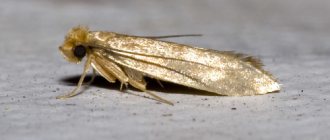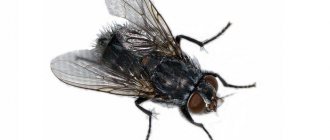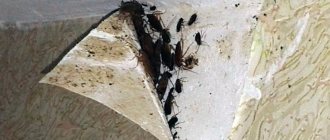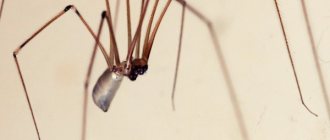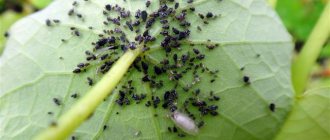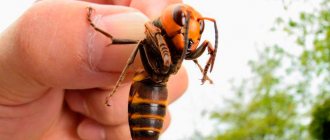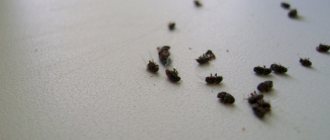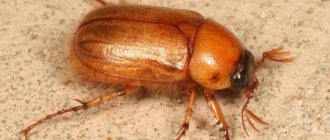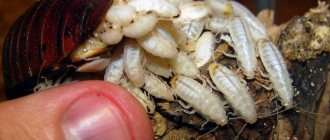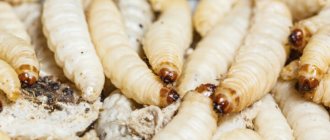As you know, uninvited guests come unexpectedly. Certainly no one prepares in advance for a meeting with beetles. They can appear at any time of the year (there would be conditions for reproduction), but most often they can be found during the warm period.
If ordinary quiet life has not gone according to plan, and neighbors who resemble cockroaches are knocking on the house, you should not immediately rush to the nearest hardware store in search of insecticides. After all, a beetle that looks like a cockroach in an apartment may turn out to be a ground beetle, a mealworm, or a leather beetle. In this case, ordinary poison for cockroaches will be ineffective.
Photos of Beetles that are very similar to cockroaches, description and why are they dangerous?
Cockroaches are one of the most undesirable neighbors for any apartment owner.
In addition to purely aesthetic rejection, insects are considered carriers of a number of life-threatening diseases, and also spoil food and furniture. But not only certain types of cockroaches can attack a house; sometimes these are completely different pests that are similar in appearance to the ubiquitous Prussians. Due to the fact that beetles belong to a different genus, conventional insecticides are powerless against them. If you encounter a “mustachioed guest” in the kitchen, you need to correctly identify him, and then look for methods to deal with him.
Cereal moth
Infected cereals can throw a treat on the hostess’s table not only with flour beetles and cereal beetles, but also with cereal moth larvae. In addition, grain moths can simply fly in through an open window or enter through ventilation ducts. The domestic pest multiplies quickly, the butterfly lays larvae in cereals, grains, flour, legumes, providing the offspring with nutrition for a long time. The hatched larvae begin to quickly feed, gradually turning into an adult insect. If you don't catch it in time, the insect will quickly destroy all your supplies. The cereal moth is not a carrier of infections, since it is only interested in cereals, but you should not eat cereals contaminated with larvae. Even if you clean it of larvae and eggs, you will not be able to eliminate house insect excrement.
You need to fight cereal moths in the same way as other household pests of cereals: first throw away all spoiled food, and then completely disinfect the kitchen.
Description of species of beetles resembling cockroaches
The distinctive features of the common apartment cockroach are present in many representatives of arthropods. Dark brown color, hard shell, long mustache - attributes of a domestic pest and other beetles.
Although the list of parasites that can take root in a person’s home is not so long.
Bread ground beetle
The insect's natural habitat is fields, where the beetle annually causes serious damage to the crop. In the presence of favorable conditions, the pest calmly leads a vigorous life activity in an ordinary apartment/private sector. The beetle is lured here by the remains of crumbs, food not cleared from the table, dirty dishes lying in the sink for a long time, and an overflowing trash can. If the insect finds a stable source of food in the home, then soon the beetles will fill the entire living space.
The ground beetle forages for food at night, and while searching, it rustles loudly and crawls into the bed, preventing its owners from sleeping. The main distinguishing feature of the beetle is its ability to fly. The ground beetle is attracted to light, so it is not uncommon for a beetle to fall onto sleeping residents from the ceiling.
Carpet beetle
It is difficult to confuse it with a cockroach (unless it is a young one) due to its small body size (4 mm is the maximum for them). They quickly master any place where there is heat. Most often, the insect can be found near the windowsill, in old wooden frames, books, cabinets, upholstered furniture, and carpets.
The main danger of the beetle is a painful bite, after which infection with helminths can occur. Carpet beetles and larvae are omnivorous; parasites are attracted to food, garbage, wool, and almost all types of fabrics.
Water bug
An insect visually similar to red cockroaches. Unlike indoor Prussians, it has a larger size, plus aggressive behavior. The kitchen/bathroom becomes attractive to them when there are constant leaks from the sewer pipes.
High humidity and unsanitary conditions are all that a beetle needs to reproduce. The pest can be distinguished by the color of its shell (dark brown, without a hint of a red tint). You should not try to catch a beetle; the bug will not run away like classic cockroaches, but will attack in response. The pest's bite is painful. Plus, the creature carries a number of infectious diseases.
Cricket
Another cockroach-like species of beetle. It is difficult to visually distinguish a young individual from an ordinary Prussian from a photo. An adult cricket is huge in size compared to a cockroach. The beetle prefers to live in warm rooms with a high concentration of humidity. The ideal place for a false cockroach to live is the basements of high-rise buildings, but a cricket can live safely in the kitchen/bathroom.
A single individual cannot cause global harm to its owner (if we do not take night concerts into account). But under favorable conditions of existence, the beetles will begin to multiply, simultaneously eating food left in an unprotected place and textiles.
Flour beetle
An arthropod parasite that chooses cereals, bran, and flour as its habitat. It reaches a length of 1.5 cm. It enters the kitchen along with contaminated cereals and quickly spreads to all human supplies.
There is no point in trying to sort through the products; this cleaning method will only remove adult cockroach-like individuals, while small larvae and the results of the beetles’ vital activity will remain invisible. If you leave the cereal in which the beetles used to live, after a couple of weeks the cockroach-like pests will reappear in the kitchen. The only way out is to recycle the products.
Black beetle
A type of domestic pest, reaching a length of 3 cm. It is the oldest representative of the genus. Despite the name, the color of the synanthropic beetle can be black, dark gray, brown, or brown. The shell makes a cracking sound when pressed. On the back are the wing rudiments, which atrophied during evolution. The black cockroach has an interesting feature that is absent from ordinary kitchen cockroaches - an unpleasant musty smell.
The parasite is a carrier of dangerous diseases (helminthiasis, E. coli, diphtheria, dysentery, typhoid fever). As it moves through sewer pipes, harmful microorganisms infesting there settle on the beetle’s legs. Once in the kitchen, the cockroach automatically infects all areas where it runs, including food.
Black cockroaches are less mobile than cockroaches. Improvements in insect control means are leading to a systematic reduction in the population. Typical habitats are gradually occupied by red cockroaches (they are less demanding in terms of living conditions, food, and are able to quickly develop new territories).
Grinder beetle
Another creature that resembles a cockroach. It can be recognized by its slightly rounded body shape. On average it grows up to 10 mm, the shell is painted in various dark shades, there are no wings. The beetle, visually similar to a cockroach, is active exclusively at night.
It poses no threat to humans, but actively damages furniture. The pest is capable of gnawing entire tunnels of passages in a tree. There is a bread variety of beetle that feeds on flour, including all types of products made from it.
Double-tailed
A well-known pest among owners of private buildings. They look similar to cockroaches, but have a forked tail. Another minor difference is the inward shape of the antennae. Color – different shades of brown (depending on the age/living conditions of the individual).
Two-tailed fish prefer to live underground, but periodically climb out through cracks in the floor to the surface. Found in a floor rag, dirty, wet underwear. When the moisture level at the base of the foundation rises, the beetles temporarily move to the top of the structure. They annoy their owners by crawling into clothes, shoes, and bed. The bite of these beetles is painful.
Reviews
Inna, 26 years old, Voronezh:
“In our apartment, cockroaches appeared first as single ones in sight in the bathroom, then every day their number began to increase throughout the apartment. It turned out that they came to us from the neighbors who had moved out through the ventilation shaft. There were openings in the bathroom and toilet through which insects crawled. The cracks in the walls and floors were carefully bricked up and additionally treated with boric acid. They didn't appear again."
Denis, 24 years old, Omsk:
“In July we moved into a rented apartment, it turned out that it was infested with cockroaches. These creatures did not crawl out during the day; the “movement” itself began at night. They didn’t change the apartment, they poisoned the cockroaches with Global, until they seemed to come back.”
Black bugs can occur in absolutely any family. The problem must be eliminated comprehensively, maintaining a high level of cleanliness, killing not only pests, but also egg laying. It is necessary to take absolutely everything into account: the storage conditions of food, the presence of cracks in floors and walls, and the general situation with insects in the entrance. If the number of insects approaches catastrophically high levels, it is better to immediately involve the help of specialists.
*Prices shown are current as of September 2022.
Methods for controlling beetles and cockroaches
The choice of method of confrontation with uninvited guests depends on what kind of beetle has settled in the apartment. All existing methods of combating beetles similar to cockroaches can be divided into 3 groups.
These include:
The safest are the use of folk remedies and mechanical cleaning of the apartment. The two methods will be of little use if the area is literally infested with cockroaches/bugs, reminiscent of the ubiquitous pests. Such an effective mechanical option as exposure to high temperatures is often not acceptable for apartment conditions.
Freezing in winter is impossible for purely physical reasons (due to the presence of central / individual heating), and heating cannot be used in relation to household appliances (although it is their body that beetles often choose for nesting).
A more effective way to get rid of beetles is to use insecticidal chemicals. Nowadays, stores sell a huge selection of different products. They differ in format (aerosol, gel, chalk, pencil, powder), list of insects against which the composition will be effective, and manufacturer’s brand.
Facilities
Effective remedies for controlling beetles similar to cockroaches:
- The most common means of fighting insects is aerosols. These include “Dichlorvos. Varan A”, “Raid”, “Raptor”, etc. Destroy both crawling and flying insects (cockroaches, ticks, bedbugs, etc.)
Composition "Dichlorvos. Varan A": tetramethrin 0.04%, permethrin 0.4%, piperonyl butoxide 0.3%, fragrance less than 5%, functional additives less than 5%, butane/propane/isobutane mixture more than 30%, solvents more than 30%.
Average price 160 rub.*
- Gels are the safest among all insecticides. It is not necessary to isolate children and animals during processing. The pastes have a bitter taste and smell, so animals will not eat them. Do not apply directly to furniture, as damage may occur. Better on cardboard, sheets of paper, etc. The peak of action occurs after two to three weeks.
Gels and pastes can be purchased as follows, “Raptor”, “Dohlox”.
Average price - 347 rubles.
- Powders for dilution. The solutions are intended for spraying floors, walls, window sills and baseboards; you must work strictly with masks and gloves. They paralyze the nervous system of bugs and cockroaches, which subsequently die. After treatment, ventilate the room.
Interesting fact! The best, “Tornado”, “Clean House”.
Prevention of cockroaches and beetles
To prevent an individual who accidentally runs into an apartment from wanting to stay there, you need to follow simple rules.
For the most part, the efforts made relate to sanitary cleaning of the premises and blocking the entry routes of pests:
No one is safe from the sudden appearance of beetles in an apartment. Cockroaches and other dangerous pests take up residence in humans. The first thing you should find out is the type of insect that attacked the home. The correct strategy for combating beetles depends on this.
Ammonia from cockroaches
Does bay leaf help against cockroaches?
What bedbug bites and the parasites themselves look like: photo
White insects live in the toilet and bathroom: crawl, run fast, what to do
Bugs in cereals - 5 ways to get rid of them in the kitchen, can the products be used?
Phosphate-free powders for children, rating of the best and names of manufacturers
Source
Ants
You can get rid of friendly lines of ants wandering into your kitchen for prey using a proven remedy for cockroaches - boric acid powder. Add a teaspoon of powder to a small portion of minced meat or mashed potatoes and roll into balls - they will be a poisonous bait for ants.
Corn flour or aromatic jam mixed with yeast is also dangerous for the stomachs of insects. Garlic aroma also repels ant communities, so you can try smearing the beaten paths leading to your table with garlic juice. In addition to home recipes, there are insecticides designed to kill insects in apartment conditions.
Bugs that look like cockroaches are not dangerous
Black beetles that look like cockroaches are carpet beetles. There are different types of cockroaches, black sewer cockroaches are very dangerous, so you need to be able to distinguish them from black almost harmless carpet pests.
Beetles are a huge group of insects (more than 400,000 species) that eat a wide variety of foods. And if beetles similar to cockroaches appeared in the apartment, this does not necessarily mean that these particular guests showed up at your place. To correctly identify those who disturbed your peace of mind, start by studying photos and videos of various household pests.
Bugs
If everything is clear with cockroaches, then strange bugs in the kitchen cause the greatest concern for housewives. Since there is not enough information on these insects, it is difficult to even simply identify what kind of bugs attacked your products.
Possible options for domestic beetles:
- The small brown bugs are wood beetles or furniture borers. Insects feed on wood, so they are only interested in your furniture, or at least crackers.
- Mucoed beetles are very similar to tree beetles (the second name is cereal beetle), although their body is more elongated and oblong. Flour eaters live in kitchen cabinets where cereals and flour are stored. Beans, cookies and dried fruits are also of interest to flour eaters.
The appearance of a grinder or flour eater is a reason to conduct a thorough inventory of food supplies in the cupboard. It is better to throw away all products contaminated with insects. The next stage is disinfection of cabinets and drawers. It is best not to assume that if you thoroughly wash one cabinet where the bugs were noticed, the insects will disappear. Give your kitchen a thorough cleaning, only then can you count on some results. Use household chemicals to treat surfaces. Some housewives managed to get the bugs out after treating the boxes with vinegar. To prevent insects from appearing again, place bay leaves or peeled garlic cloves in cabinets. Unpeeled cloves can be added to containers with cereals; this will also repel pests.
Place of the cockroach among other beetles
All beetles undergo complete metamorphosis throughout their lives: the nymph of a beetle does not resemble an adult insect.
You can tell an insect is a beetle if its outer pair of wings are “elytras” that protect the flying wings below. Beetles belong to the order Coleoptera. If the insect has hard, shield-like wings, it is a beetle.
Cockroaches, along with termites, are in the order Blattodea. The data varies, some researchers count at least 5,000 species of cockroaches, among which there is even such an exotic as the hairy cockroach. This species undergoes incomplete metamorphosis, which means that the small cockroach looks exactly the same as the adult, but it is smaller and wingless. Cockroaches have two pairs of wings, and the top pair will be leathery, but not hard, like a beetle's wing.
You can usually also tell that it's a cockroach if the head is barely visible from above: cockroaches usually hide their heads under an enlarged "pronotum." For example, with giant hissing cockroaches (which have no wings), you can't see their heads at all, only their antennae peeking out.
Cockroaches and beetles can be easily distinguished by the appearance of their wings. The beetle's elytra are symmetrically located in the middle, and the wing veins are straight and parallel. In contrast, cockroaches' wings fold toward each other, and the wing veins branch or are shaped like leaves.
Cockroaches rarely bite, but beetles can cause some damage to humans with their massive mouthparts, usually when they feel threatened.
Types of cockroaches
You, of course, have heard that there are albino cockroaches, Australian, Asian,
Cuban cockroaches, field, flying, green, pale field, sand, Turkmen and so on ad infinitum. Below is a list of the most common pests found in homes. There are Madagascar cockroaches, banana cockroaches, white cockroaches, and rhinoceros cockroaches.
German cockroaches
Blattella germanica is one of the most common species.
The rufous prxsak is 13 to 16 mm long and pale brown in color, with two dark brown stripes behind the head. These insects typically live up to 12 months and produce more eggs than other species.
American cockroaches
Periplaneta americana are the largest cockroaches commonly found in homes. Adults can grow up to 53 mm in length. They are reddish-brown or brown in color with light yellow stripes around the shield behind the head.
Both males and females of this species have wings and are capable of flying short distances. American cockroaches can live up to two years and are commonly found in households where food is stored.
Brown-striped cockroaches
Supella longipalpa grow up to 13 mm. Females have reddish brown to dark brown wings. The wings of male brown banded cockroaches are dark brown towards the base and lighten as the wings reach the tip.
Only males are capable of flight. Both males and females have two light yellow stripes on their body. This species jumps when its calm is disturbed. They live on average from three to 11 months.
Oriental cockroaches
Blatta orientalis has shiny, dark brown or black bodies. Females can grow up to 32mm in length, while males are usually less than 25mm in length. They are not able to fly. Their lifespan is up to six months.
Flying arthropods
Some insects fly through open windows and doors and settle in the house for a long time. They can be seen with the naked eye and a fairly loud buzzing sound can be heard.
Flies . According to recent research, most flies sleep at night and doze during the day. The fly has a complex eye structure. It consists of thousands of lenses, which gives her the ability to see in many directions at the same time. Sensitive villi on the fly's body allow it to hear sound vibrations. Their taste buds are on their paws. When choosing food, flies moisten it with saliva and absorb it. Then they burp it to soften it, and then suck it up with a sponge-like mouth. They eat constantly, as well as mate. Flies live for about three weeks.
Wasps . They often make their nests in people's homes. Usually these are attics, balconies, loggias, verandas. They build nests from chewed wood and fiber. Wasps often drink water as well as sweat from people's skin. Every year about 1.5 thousand people die from their bites. But nevertheless, they provide benefits by eating other insects.
Moths are a well-known household pest, a lepidopteran insect. Moth larvae eat not only fabric, but also products of plant origin: grains of wheat, corn, barley, oats, and also eat flour and even dry bread. Moths are known to enter the home when attracted to bright light. And when they get into a home, they settle in it forever.
Other household pests
Bugs, like all creatures, have their rightful place on this earth. But no one wants this place in our house. But, whatever one may say, insects make their way into our homes.
Dust mites
As annoying as it may be, there are dust mites in every home. Because they feed on dead skin cells, dust mites can thrive on any fuzzy surface that might contain tasty particles, be it carpet, upholstery, bedding or children's toys. While you can't completely eliminate mites, you can reduce their numbers by practicing regular cleaning practices.
Wash bedding in hot water at least once a week, and vacuum carpets and furniture regularly. To remove dust mites from stuffed animals or items you don't want to wash, place them in the freezer. Seal the items in a ziplock bag and place the bag in the freezer for at least 48 hours—dust mites will not survive a deep freeze.
Weevils
These insects typically enter your home from the grocery store. Adult weevils take up residence in rice and other grains to lay eggs, so you may not know you brought pests home until they hatch and are crawling all over your pantry!
The fastest cure for infection? Get rid of any unsealed dry foods, including flour, cornmeal, oats, rice, pasta and packaged foods that come in pre-opened bags. Then discard anything unpacked as soup mixes or gelatin. Even if weevils don't eat these foods, they may enter drawers to hide, only to emerge later to contaminate your food. After you've thrown away the infested food, clean out your pantry shelves and spray the entire area with insecticide. Once the liquid has time to dry, you can replenish the supply.
centipedes
They can be classified as beneficial insects. They don't destroy your home or pollute your pantry, but instead feed on bad bugs like termites, moths, and cockroaches. But if you just don't like coexisting with these multi-legged neighbors, trap them or spray insecticide around baseboards, doors and windows. In the meantime, prevent future infestations by sealing cracks and crevices where they might enter the home. Millipedes thrive in moist environments, so you may also want to invest in a dehumidifier.
Fruit midges
It's amazing how quickly a fruit fly infestation can get out of control. You might notice one fly buzzing around your fruit in the morning and then come home from work to see half a dozen more. It's not your imagination; These flies are multiplying - and fast! Fruit fly larvae hatch within 24 hours of laying eggs, so you will need to act quickly to get rid of them.
Place the fruit in the refrigerator. Also, immediately wipe down cutting boards and counters after preparing food and throw away trash daily. If, despite these preventive measures, you notice a few fruit flies, create a simple trap by filling a small glass halfway with apple cider vinegar. Then add a tablespoon of dishwashing liquid and leave the glass. The flies will fly into the glass, but will not fly out.
Fruit midges
As soon as fruits or berries appear on the table, they are immediately surrounded by small flying insects - midges. Midges in the kitchen are fruit flies or fruit flies. They are attracted not only by slightly spoiled fruits, but in general by the processes of decay affecting products of plant origin.
The multiplication of insects can only be stopped by careful control of fruits, vegetables, berries and potted house plants. Feel free to throw away spoiled fruits or vegetables, or better yet, eat vitamin-rich foods on time.
Homemade traps will help get rid of already appeared fruit flies.
To attract fruit flies, you will need fruit juice or pieces of rotten fruit. Place the “treat” in a container with a narrow neck, make a funnel from a sheet of paper and use it to further narrow the passage into the bottle. Having flown to the scent of the bait, the insects will not be able to get out.
Place a slice of watermelon or melon in a plastic bag and leave it open overnight. By morning there will be a lot of fruit flies in the trap. All that is required of you is to approach the trap as quietly as possible and close it with a quick movement of your hand. Then dispose of the insects along with the bait.
stink bugs
These aliens usually live and breed outdoors, but when temperatures get cooler, they often make their way indoors to hibernate. If you see these shield bugs in your home, do not try to hit or squash them. When disturbed, stink bugs live up to their name by emitting a foul odor that only attracts more stink bugs. Try removing them with a vacuum cleaner. The only catch is that when you're done, you'll have to remove the vacuum bag and dispose of it a safe distance from your home.
Ants
Tiny but merciless home invaders. They enter your home in search of food, water and shelter, which means your kitchen and bathroom are their prime targets. Although baited traps are very effective at killing ants, they are not entirely safe for use in areas where small children or pets may enter.
If you don't want to use traditional poisons, there are a number of natural remedies you can try. Once you've managed to get rid of these pests, discourage them from coming back by vacuuming regularly, wiping down surfaces every day to remove their scent, and taking out the trash every day.
Sewer flies
Drain flies live deep in sticky, murky drains. The reason you find drain flies in your sink or shower is because they feed and lay eggs in the decaying debris that lines clogged drains. If you notice drain flies buzzing around your sink, you need to correct the situation immediately. First, determine which drain they are coming from.
Most likely, there is a blockage in this drain. You will need to clean it before you can get rid of the unpleasant neighborhood. Use a drain brush to clear out any accumulated mucus, then open the drain under the sink to remove any remaining clog. Close the system again and finish by pouring the enzyme cleaner down the drain to remove residue and any remaining fly eggs.
Shimmering and sliding silver
Another insect you never want to see indoors. This pest will feed on fabric, paper, glue and cardboard boxes. Silverfish are such an ancient creature that they even predate dinosaurs. Therefore, it is difficult to drive them out of the house once they are there. However, you can get rid of them using traps, insecticides, or natural substances such as boric acid or diatomaceous earth.
To make sure the silverfish are driven away, make a few small changes to make your home less hospitable to them. Remove folded newspapers, junk mail and old cardboard boxes. Store out-of-season clothing and supplies in plastic containers, and remove your dry goods from boxes and store them in containers with tight-fitting lids.
Getting rid of unwanted neighbors
Getting rid of bark beetles should not be delayed. At the first sign of their presence, take measures to destroy them. There are several ways to remove the pest. They are divided into:
-
Contact
. “Clipper”, “Antizhuk”, “Empire-20” are considered effective defense weapons. The substance included in their component destabilizes the possibility of reproduction - the beetles will not be able to lay eggs, and their number in the house will noticeably decrease.The preparations are poured into the cracks, then covered with plasticine. The product penetrates into the body of the barbel, inhibits its metabolic abilities, and the parasite dies. Use insecticides before starting to build a house made of timber; treat the tree annually for preventive purposes. Read the instructions carefully; the drugs require careful use because they are poisonous.
- Intestinal
. Control means are poisonous baits that attract barbels. Having tried them, the bark beetles will die.
Insects similar to cockroaches
If you find tiny black beetles crawling around your home, don't panic. If you and your pets are not suffering from bites, the pests are probably not bed bugs or fleas.
Carpet beetles
Although carpet beetles may eat wool, silk, or flakes, they do not bite and will not cause structural damage to your home. If they leave a black or brown smear when crushed, you most likely have carpet beetles.
They feed on carpets and similar foods and reproduce slowly.
Carpet beetles are only 2-3 millimeters long - about the size of a pinhead - and vary in color. Some are black or dark enough to appear black when observed by the human eye. Others may be spotted, with brown and black spots on a lighter background. Like many other beetles, they are round or oval and convex, like ladybugs. Carpet beetles are covered in tiny hairs that are difficult to see unless you look at them under magnification.
Carpet beetle larvae are elongated and appear fuzzy or hairy. They leave behind their shed skins so you may find them in infested pantries, cupboards or drawers.
Folk remedies
Boric acid is a popular remedy for almost all types of beetles. When the beetle eats acid, it infects other beetles with it and dies. One way to get rid of pests is to mix powdered sugar with boric acid powder on a piece of paper.
Separately, the powder can be used to treat baseboards, cracks in floors, the back surface of carpets, etc.
Herbs help eliminate black beetles that look like cockroaches in apartments.
It is known that skin beetles cannot tolerate the smell of lavender. It should be placed in cabinets and on window sills. If it is not possible to use real lavender, you can use cotton pillows soaked in lavender oil or scented sachets. However, essential oils do not affect beetle larvae, so after a while they may appear in the apartment again.
Interesting fact! Cockroaches cannot tolerate the smell of tansy. Dried preparations can be placed around the apartment, they will protect the home from unwanted running reptiles.
How to remove insects?
In large numbers, carpet beetles can cause significant damage to sweaters and other clothing and can infest pantry items. Professional extermination is not required. You just need to thoroughly clean the areas where carpet beetles live.
Getting rid of carpet beetles
First, clean out your pantry. Check all food storage areas—closets and pantries, as well as the garage and basement—for adult and larvae of live carpet beetles. If you notice signs of tiny black bugs around your food, throw away all food from the areas where you see the infestation. Wipe down shelves and cabinets with a regular household cleaner. Do not spray insecticides on food storage areas; this is unnecessary and will do more harm to you than to the insects.
Next, clean out your closets and dressers. Carpet beetles love wool sweaters and blankets. If you see signs of carpet beetles—adults, larvae, or skins—take non-washable items to the dry cleaner. Wipe down the insides of drawers and shelving with a household cleaner, not a pesticide. Vacuum your closet floor thoroughly, using a crevice tool on baseboards and corners. If you can, store clothes you don't use in airtight containers.
Finally, thoroughly vacuum upholstered furniture and all carpets. Carpet beetles tend to hide under furniture legs, so move furniture and vacuum underneath thoroughly.
Spitting spider
0
Source:
As mentioned earlier, this list will feature more than one species of spider. Spiders of this species catch prey by spraying a liquid onto it, which neutralizes it by solidifying into a toxic and sticky mass upon contact. You can observe the habit of spiders swaying from side to side. They do this to wrap up their prey. Most spiders are only capable of producing silk, but Scytodes spitting spiders are an exception. Together with the silk, they release poison from their mouths, and silk strands soaked in the toxin, falling on the spider’s victim, bind it. These spiders are not dangerous to humans, do not weave large trap webs, and are unremarkable in appearance. But they still have one peculiarity - during the hunt they “spit” their prey. This may sound a little harsh, but it's accurate. This is why they got their name “spits”. Spitting spiders live in both warm tropical and temperate regions, including Russia - in human homes, where it is warm.
What to do if insects don't go away
If carpet beetles remain a problem in your home, there are other great ways to get rid of these insects without calling a pest control professional or using pesticides. Below are the main methods.
Use peppermint oil
Are mosquitoes, ants or even spiders a nuisance in your home? Not only will peppermint get rid of such insects, but it will also make your home smell nice with its sweet aroma. Add eight drops of natural peppermint oil to a glass of water, pour into a spray bottle, shake, and then spray around vents, doorways and windows.
Use diatomaceous earth
Diatomaceous earth is made from single-celled algae that have been fossilized and ground up. If your home has been invaded by stink bugs, flies, bed bugs, beetles and spiders; Diatomaceous earth will help you. It is not harmful to humans, but is lethal to small, black, hard-shelled beetles inside the home. It only takes 48 hours after this black carpet beetle's exoskeleton comes into contact with it for the insects to dehydrate and die.
Harvesting spider
0
Source:
Hay-making spiders that build trapping webs are ubiquitous. Hanging upside down on their jumbled, tangled, uneven web. Webs are built in dark, damp niches of caves, trees and under stones, in lairs abandoned by mammals, for example, in cellars and various buildings. In human homes, they love dry and warm places near windows. How dangerous are harvest spiders to humans? Suffice it to say that they spend the poison they have exclusively on their victims, inflicting a paralyzing bite on them. He is not enough for anything more. The main reason for declaring war on arachnids is arachnophobia. Some people cannot even stand them visually; for others, a creature that gets on their body causes panic. The problem is so serious that psychologists are working on it.
